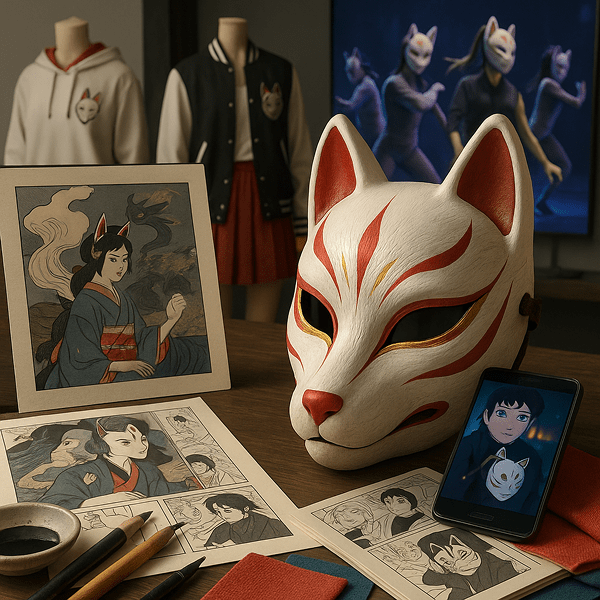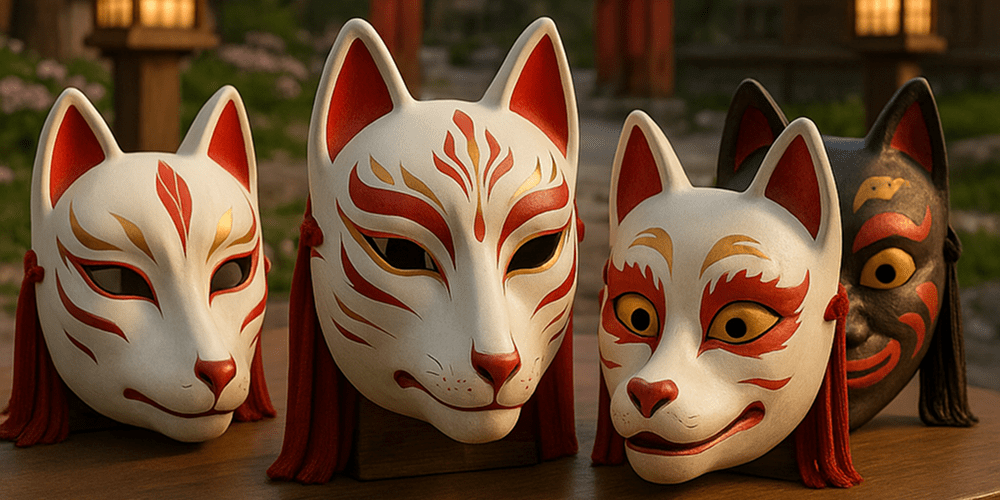Kitsune masks are among the most recognizable and enchanting elements of Japanese culture. These masks, depicting the face of a fox (kitsune in Japanese), are imbued with layers of myth, folklore, and artistry. Characterized by their elegantly elongated snouts, pointed ears, and expressive, often mischievous, features, kitsune masks are typically painted in white, sometimes adorned with red, gold, or black details that accentuate their supernatural allure. Kitsune masks are an integral part of Shinto festivals, Noh and Kyogen theatre, and popular culture, with their origins stretching back centuries in various regions of Japan, especially those closely linked to the worship of the fox deity Inari.
Historical Origins
The history of the kitsune mask is deeply interwoven with the evolution of Japanese spirituality and performing arts. The word “kitsune” (狐) simply means “fox,” but in Japanese folklore, foxes are seen as mystical beings capable of transformation and possessing great intelligence. Kitsune masks likely originated from ancient agricultural rituals and the veneration of the Inari deity, the Shinto god or goddess associated with rice, fertility, and prosperity, for whom foxes serve as sacred messengers.
The earliest kitsune imagery can be traced to the Nara period (8th century), with the mask form emerging more strongly during the Heian and Kamakura periods. The use and design of kitsune masks evolved alongside religious festivals, the proliferation of Inari shrines, and the development of Japanese theatre. Key historical artifacts include painted scrolls, shrine carvings, and early theatre masks that show fox-like features. Over time, the mask’s function expanded from ritual use to entertainment and, later, to popular celebrations.
Cultural Significance and Symbolism
In Japanese culture, the kitsune mask is much more than a decorative item — it is a potent symbol. The fox is both feared and revered as a supernatural being, capable of shape-shifting (often into a beautiful woman), trickery, and even possession. Kitsune masks are worn to invoke these qualities, offering the wearer protection, cunning, and a link to the spirit world.

Spiritually, kitsune are closely associated with Inari worship. During festivals such as the Inari Matsuri, masks are worn in processions and rituals to honor the deity, seek blessings for good harvests, and ward off evil. Kitsune also appear in countless Japanese myths, such as the tale of Tamamo-no-Mae, a legendary fox spirit who took human form. Socially, kitsune masks signal participation in communal rites and reinforce the connection between humans and the divine.
Materials and Craftsmanship
Traditional kitsune masks are crafted from a variety of materials, most commonly carved wood, papier-mâché, or molded ceramics. Artisans use tools such as chisels, knives, and brushes to shape and decorate the masks. The process involves careful carving or molding, smoothing, priming, and then painting with natural or synthetic pigments. Traditionally, white is used as the base color, symbolizing purity and the spiritual nature of foxes; red signifies protection and power, while gold and black add decorative elegance.
Regional differences exist: in Kyoto, masks may feature more delicate lines, while Edo-era masks from Tokyo are often more robust and stylized. Some masks include additional adornments such as bells, ribbons, or decorative cords, enhancing their ceremonial presence.
Functions and Uses
Kitsune masks serve diverse purposes. Originally, they were used in Shinto rituals and Inari festivals, worn by priests, dancers, or community members to invite the presence of the fox spirit and ensure fertility and prosperity. In classical Noh and Kyogen theatre, kitsune masks are essential props, used to portray fox characters in dramatic and comedic plays.
During the annual Oji Inari Fox Parade in Tokyo or at Fushimi Inari Taisha in Kyoto, thousands don kitsune masks in processions. Over time, the masks have also become popular at New Year celebrations, local matsuri, and even as decorative items in homes and shops. In the modern era, kitsune masks appear in cosplay, fashion, and art, reflecting both traditional reverence and contemporary creativity. Just as Kitsune Masks embody the mysterious and enchanting aspects of Japanese folklore, Oni Masks are another iconic element often seen in festivals and performances, representing powerful demons and serving both protective and dramatic functions.
Regional Variations
While the core design of the kitsune mask is widely recognized, regional variations add local flavor. In Kyoto and the Kansai region, masks often have refined features and subtle color palettes. In Kanto (Tokyo), masks are bolder and sometimes oversized for street festivals. Smaller towns may have unique shapes or incorporate local symbols into the mask’s decoration. Similar fox masks can be found in Chinese and Korean traditions, but the Japanese kitsune mask is unique in its integration with Inari worship and its specific role in folk festivals and theatre.
Notable Examples and Collections
Significant historical kitsune masks are preserved in major Japanese museums such as the Tokyo National Museum, the Kyoto National Museum, and local shrine collections. Noteworthy artifacts include Edo-period theatre masks, ceremonial masks from Fushimi Inari Taisha, and rare examples exhibited in the National Museum of Japanese History. Private collections, such as those featured on ToddMasks.com, often display both antique and contemporary masks, highlighting the artistry and diversity of this tradition.
Influence on Art and Culture
The kitsune mask has had a profound impact on Japanese art, literature, and pop culture. It appears in classic woodblock prints, modern manga and anime (such as “Naruto” and “Spirited Away”), and is referenced in music and fashion. The mask’s enigmatic allure has inspired designers, choreographers, and filmmakers, both within Japan and internationally. It serves as a symbol of transformation and mystery, fueling ongoing artistic experimentation and cultural exchange. Kitsune masks remain a popular motif in contemporary design, helping to keep traditional aesthetics alive in new contexts.

Contemporary Status and Preservation
Today, the tradition of kitsune mask-making is maintained by skilled artisans and supported by educational institutions, festivals, and cultural programs. Workshops and demonstrations are offered at major shrines and community centers, with some modern artists innovating with new materials or digital techniques. These efforts are vital for the transmission of craft knowledge to new generations. Organizations and websites like ToddMasks.com play a key role in documenting, preserving, and promoting the art of kitsune mask-making, ensuring its relevance in a rapidly changing world.
Collecting and Acquisition
The market for kitsune masks ranges from inexpensive festival souvenirs to high-value antiques and artisan-crafted pieces. Authentic masks can be acquired at shrine shops, specialized galleries, and reputable online platforms. Prices vary depending on age, material, provenance, and craftsmanship. Collectors are advised to seek provenance and authenticity certificates, and to respect ethical guidelines — especially regarding the purchase of antique or sacred masks. Supporting living artisans and purchasing through trusted sources helps sustain the tradition and protects cultural heritage.
